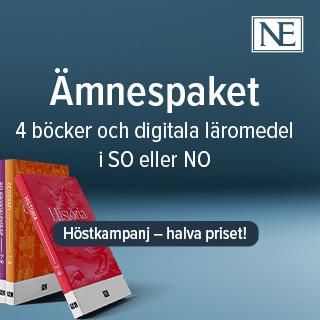Designing new learning experiences? Exploring corporate E-learners’ self-regulated learning
Digitala miljöer möjliggör, men kräver också ett nytänk kring själva lärkulturen. Det visar Annika Wiklund-Engbloms avhandling om e-lärande.
Annika Wiklund-Engblom
Sven-Erik Hansén, professor emeritus, Åbo Akademi
Staffan Selander, professor Stockholms universitet
Åbo Akademi
2015-08-28
Design av nya lärupplevelser? En undersökning av självreglerat digitalt lärande i företag
Designing new learning experiences? Exploring corporate E-learners’ self-regulated learning
Fakulteten för pedagogik och välfärdsstudier
Design av nya lärupplevelser? En undersökning av självreglerat digitalt lärande i företag
Den svenska titeln på avhandlingen är ”Design av nya lärupplevelser? En undersökning av självreglerat digitalt lärande i företag”. Frågetecknet i titeln hänvisar till hur svårt det är för oss att på förhand veta hur ny digital teknologi kommer att påverka oss och skapa nya upplevelser. Den mest ihärdiga frågan när det gäller digital design för lärande är vad som egentligen är en bra design.
I avhandlingen granskas hur två iterationer av en digital kursdesign i ett företag stöder de lärandes självreglering. En självreglerad lärande har förmågan att hantera och kontrollera den digitala lärsituationen trots att den kanske inte stöder lärandet på samma sätt som en traditionell lärsituation där en lärare finns närvarande. Studien utforskar de lärandes handlingar och intentioner med fokus på kognition, emotion och beteende.
Resultaten visar att t.ex. feedback triggade de lärande att utforska kursinnehållet mer målinriktat och stödde deras självreglering. Typen av bedömning i kursen påverkade även hur de lärande tog till sig materialet och hur de manipulerade den digitala miljön. Studien visar att självreglerat lärande påverkas av tre sammanlänkade dimensioner. Lärupplevelsedimensionen består av ett dynamiskt affekt-kognitions-kontinuum av både positiva och negativa upplevelser. Självregleringsdimensionen handlar om den lärandes medvetenhet om hur hen kan vara självreglerad och hantera den digitala miljön för sitt eget lärande på bästa sätt. I avhandlingen kallas denna förmåga för designförankrad epistemisk metareflektion. Innehålls- och kontextdimensionen innefattar de förutsättningar den digitala designen ger den lärande att lära på ett effektivt och utvecklande sätt; hur den stöder den lärande att utveckla förmågan till designförankrad epistemisk metareflektion och på så sätt bli självreglerad i sitt lärande i förhållande till just den lärdesignen.
Slutsatser som kan dras av studien är att i designen av digitalt lärande i företag är det viktigt att beakta de lärandes direkta behov av kunskap och skapa flexibla förutsättningar för att dessa behov tillfredsställs på rätt sätt. Digitala miljöer möjliggör, men kräver också ett nytänk kring själva lärkulturen. Det här är speciellt viktigt i företag där problem ofta löses med hjälp av att man i grupp förhandlar sig fram till vad den bästa lösningen är här och nu, snarare än att det finns endast ett enkelt svar på en fråga. Kunskap föråldras snabbt och digital lärdesign kan stöda företagen genom att fungera som sociala nätverk där kunskap skapas i en kontinuerlig förnyelseprocess. Därmed bör design av digitala kurser snarare byggas enligt en modell av ett socialt ekosystem än som öar av individuellt lärande.
Designing new learning experiences? Exploring corporate E-learners’ self-regulated learning
The context of this study is corporate e-learning, with an explicit focus on how digital learning design can facilitate self-regulated learning (SRL). The field of e-learning is growing rapidly. An increasing number of corporations use digital technology and elearning for training their work force and customers. E-learning may offer economic benefits, as well as opportunities for interaction and communication that traditional teaching cannot provide. However, the evolving variety of digital learning contexts makes new demands on learners, requiring them to develop strategies to adapt and cope with novel learning tools. This study derives from the need to learn more about learning experiences in digital contexts in order to be able to design these properly for learning.
The research question targets how the design of an e-learning course influences participants’ self-regulated learning actions and intentions. SRL involves learners’ ability to exercise agency in their learning. Micro-level SRL processes were targeted by exploring behaviour, cognition, and affect/motivation in relation to the design of the digital context. Two iterations of an e-learning course were tested on two groups of participants (N=17). However, the exploration of SRL extends beyond the educational design research perspective of comparing the effects of the changes to the course designs. The study was conducted in a laboratory with each participant individually. Multiple types of data were collected. However, the results presented in this thesis are based on screen observations (including eye tracking) and video-stimulated recall interviews. These data were integrated in order to achieve a broad perspective on SRL.
The most essential change evident in the second course iteration was the addition of feedback during practice and the final test. Without feedback on actions there was an observable difference between those who were instruction-directed and those who were self-directed in manipulating the context and, thus, persisted whenever faced with problems. In the second course iteration, including the feedback, this kind of difference was not found. Feedback provided the tipping point for participants to regulate their learning by identifying their knowledge gaps and to explore the learning context in a targeted manner.
Furthermore, the course content was consistently seen from a pragmatic perspective, which influenced the participants’ choice of actions, showing that real life relevance is an important need of corporate learners. This also relates to assessment and the consideration of its purpose in relation to participants’ work situation. The rigidity of the multiple choice questions, focusing on the memorisation of details, influenced the participants to adapt to an approach for surface learning. It also caused frustration in cases where the participants’ epistemic beliefs were incompatible with this kind of assessment style. Triggers of positive and negative emotions could be categorized into four levels: personal factors, instructional design of content, interface design of context, and technical solution. In summary, the key design choices for creating a positive learning experience involve feedback, flexibility, functionality, fun, and freedom.
The design of the context impacts regulation of behaviour, cognition, as well as affect and motivation. The learners’ awareness of these areas of regulation in relation to learning in a specific context is their ability for design-based epistemic metareflection. I describe this metareflection as knowing how to manipulate the context behaviourally for maximum learning, being metacognitively aware of one’s learning process, and being aware of how emotions can be regulated to maintain volitional control of the learning situation. Attention needs to be paid to how the design of a digital learning context supports learners’ metareflective development as digital learners. Every digital context has its own affordances and constraints, which influence the possibilities for micro-level SRL processes. Empowering learners in developing their ability for design-based epistemic metareflection is, therefore, essential for building their digital literacy in relation to these affordances and constraints.
It was evident that the implementation of e-learning in the workplace is not unproblematic and needs new ways of thinking about learning and how we create learning spaces. Digital contexts bring a new culture of learning that demands attitude change in how we value knowledge, measure it, define who owns it, and who creates it. Based on the results, I argue that digital solutions for corporate learning ought to be built as an integrated system that facilitates socio-cultural connectivism within the corporation. The focus needs to shift from designing static e-learning material to managing networks of social meaning negotiation as part of a holistic corporate learning ecology.
Relaterade länkar

Fritidshem
 Åk F–6
Åk F–6 Matematikångest
 Åk 4–Vux
Åk 4–Vux 






